Divers who have enjoyed the “diving freedom” style of Bonaire in the southern Caribbean might be familiar with the late Captain Don, but what about the island’s other pioneering force of nature, Al Catalfumo? JOHN CHRISTOPHER FINE went out to celebrate the man’s 80th birthday with a special dive, and found him still preoccupied with keeping things real – not least the local donkey population.
Whatever happened to that kid from Sheepshead Bay, Brooklyn, New York? I hadn’t seen him in more than 40 years. The last time he was with Captain Don Stewart, who was running a dive operation out of Hotel Bonaire on a little leeward island in what was then the Dutch West Indies.
Al Catalfumo had been that wild kid with a sense of adventure when we dived the Windjammer, a deep wreck that Captain Don later complained that we had no right to dive. Over breakfast we laughed about our adventures diving off Bonaire. It was the morning Al turned 80.
Nothing had changed between us; we picked up right where we had left off 40 years before.
A gala birthday party was planned at Al’s Black Durgon Inn later that day. It was open to islanders, friends who had become Al’s family in the almost half-century he had been diving on the island.
It had taken his daughter Rona months of preparation. Neighbours and friends had worked for weeks to order food, prepare it, set about cooking and baking, erect tents on the large patio area facing the sea and tend to the myriad details required to ensure that there was ample food, libations, music and entertainment.
“We’re really not sure how many people will attend. We’ve made food for 300 – I hope it will be enough,” said Rona, rushing off to get something else done before 2pm, when guests would start to arrive at Black Durgon.
As we finished eggs scrambled to perfection by Doris, cook and housekeeper at the Black Durgon Inn for the past 28 years, Al simply inclined his head.
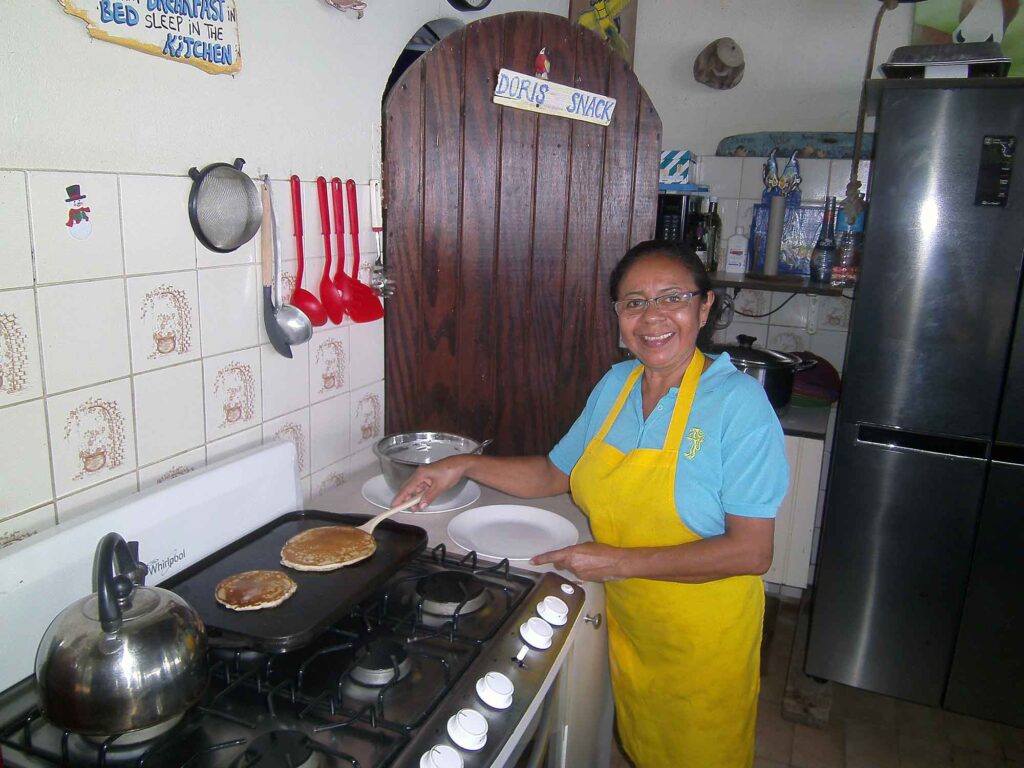
I swallowed the rest of my coffee, feet propped up on a bench facing the water. Then I left Al and went up to get tanks stowed behind a stone wall out front, handy for divers to load in their cars to take to dive-sites around the island.
Tanks were always filled and available. Al took them by truck, filled them, brought them back and ensured that there was always ample air for his guests. Today, the least I could do was bring tanks down. It wasn’t so much in consideration of Al’s 80th birthday as that I prefer to carry two tanks at once for balance. He went up anyway, to get a smaller tank that he liked to use.
“This is my wetsuit,” said Al. He pulled something that looked like an ancient fleece sweatshirt over his head. “People ask me if I have a computer. No. I don’t even wear a watch. I dive the same dive every day…”
Special award
While I had taught diving in the Mediterranean as a French instructor, Al and I had both taught scuba in the USA under the national YMCA scuba programme until it went out of existence. Those were the days of ensuring that divers were divers, and training had been rigorous.
Geared up, we walked along the dock from the locker. I had my camera. Al simply jumped off the end of the pier, while I took the ladder.

We swam out to the edge of the reef. The dive-site in front of Black Durgon, called Small Wall, is one of the most popular on the island for boat dives. Captain Don had ensured that sites around the island had been established and marked with floats. No anchoring is allowed on Bonaire – a simple yet vital precaution established by the pioneer divers to protect coral.
Small Wall drops 33m to the sand. We swam along the wall at 18m. Tucked into the pocket of my BC was a medal, designed as an award for first-prize winners of the International Poster Contest For Youth. This contest had been established 45 years ago, along with the Ocean Charter, to draw attention to marine-conservation issues.
Among the sponsors are the United Nations Environment Programme, the Explorers Club, DEMA, NAUI, Wyland Foundation, Guy Harvey Foundation, CMAS the World Underwater Federation, the Underwater Society of America and other conservation bodies.
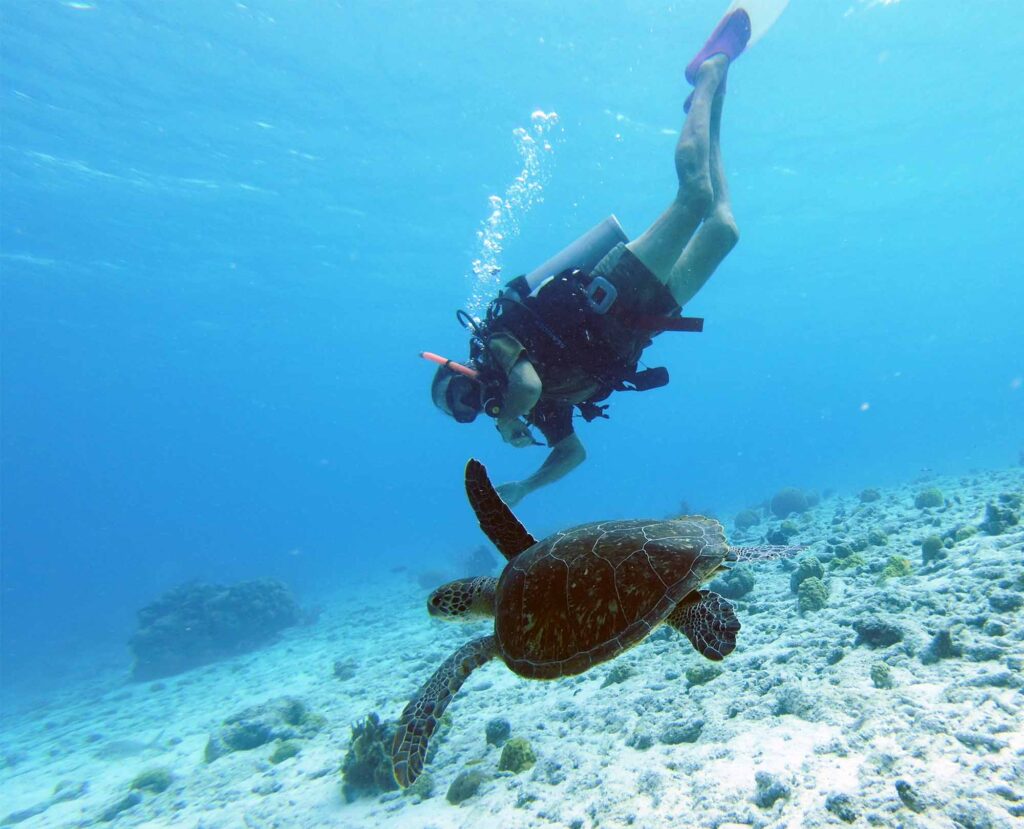

The medal has only rarely been presented, to a handful of individuals whose lives and devotion give special meaning to ocean conservation. They include Philippe Tailliez, Jacques Cousteau’s commander in the French Navy and the man who taught Cousteau to dive; Albert Falco, captain of Cousteau’s boat Calypso; Captain Don; and Dr Sally Bauer, founder of the History of Diving Museum.
I signalled Al to stop near a cavern on the reef, still at 18m. The kid from Brooklyn, a pioneer instructor from the great days of diving adventure, received his medal on a simple cord strung over his neck. It was an underwater ceremony in the tradition I had learnt diving in French territory, with medals presented for diving accomplishments. A small green turtle commemorated the event with us.
Lamp-posts on piers
Born on 14th Street and Avenue Z near the water in Brooklyn’s Sheepshead Bay, Al attended PS 209 and Abraham Lincoln High School. He and his pals would climb up lamp-posts on piers until they drew a crowd of tourists who would throw coins into the water. The kids would dive off the posts to get the coins.
“Bob owned a boatyard,” said Al. “He got his tanks from the military. One day he said: ‘Come on boys…’ That’s how we started diving. Bob started taking me diving in Sheepshead Bay.” Bob likely had a last name, but Al never knew it. His adventure diving began near home, with military-surplus dive tanks and regulators.
Al was a precocious actor. His mother got her five kids into drama classes, then started them on film and stage careers. Al was one of the original Campbell Soup kids. “I had to do a commercial for their bean soup. I hated beans. As soon as filming was over, I spat the beans out,” he remembered, laughing.
He received a hero’s commendation on the road when fire broke out in the hotel at which they were staying. Twelve-year-old Al woke to dense smoke and went from room to room, banging on doors to wake people and get them out. He received a police hero’s commendation for saving lives.
He was also fired at the age of 12. “How many people can say that?” he asks. His baby sister Flo told the story, one of many examples in which the boy took responsibility for ensuring justice.
They had both been dancers and chorus in a Rodgers & Hammerstein musical. Composer Richard Rodgers was pushing them, and insisted that a young dancer get into the next scene. Al had spoken up: “She won’t have time to change costumes,” he pointed out.
With a laugh, he related how he had received a pink slip the next day. Rodgers had fired him for speaking out. “I went on the unemployment line. The guy looked down at me, a 12-year-old kid. I had my paybook, so I got unemployment.”
Al joined the US Army at 17. He was a lifeguard at Fort Benning before being shipped over to Germany for two years as a mechanic. He became a sergeant at 19, put in charge of the motor pool: “They called me the teenaged sergeant.”
On leaving the army, he worked for Ford Motor Company in Edison, New Jersey making Mustangs. In 1969 he quit and opened Diver’s Cove on Highway 35 in Laurence Harbor, New Jersey. He conducted dive courses through the store and at local schools, including Rutgers University and Monmouth College. He taught fire and police divers.
“It became a popular dive shop,” he says. “I loved it. I asked divers who came in where they had been on vacation: Cozumel, Cayman? When they said Bonaire, all of them had been thrilled with the diving.
“I had a travel agency associated with the dive shop. I sent people all over. I put a trip together with 16 people. I dived with Captain Don at Aquaventure in November, 1974. It went so well that I planned a trip to Bonaire the first week of November every year after that.
“Captain Don took us on adventures no one has done since. Don always had some bait to dangle – I never fell for his jokes.” Remembrances from long ago. Friendships made, never forgotten, now eight years after Captain Don’s death.
“Captain Don was a colourful character. He’d come up with statements that usually triggered a response. I’d never bite. I came out of the water once and Don said: ‘Guys like you give us a bad rap. Your mask is so dirty, you’ll claim our visibility is bad.’”
Shipwrecked sailor
When I first met Captain Don long ago he had related the story of his arrival on Bonaire on the hopeless wreck of his sailboat. He had decided to remain on Bonaire. The local Dutch authorities took a look at this shipwrecked sailor and told him that he would have to make himself useful if he were to remain on the small island.
He did, and with instructors like Al Catalfumo made Bonaire a dive destination. After that first trip with 16 divers, Al organised another trip and brought 70 divers over. Ady Evertz, a friend and dive-guide Al always used, told him that Don was moving from Hotel Bonaire to Captain Don’s Habitat, so the hotel needed a dive operator.
“I told Ady: Finally my house in New Jersey is paid for, the dive shop is paid for, I’m going downhill at last, sorry no. Ady said: ‘Don’t say no.’ I woke up at 3am. How could you say no to Bonaire? I called Ady. I sent a plan to Rudy Ellis, the director of tourism.
“My proposal was accepted. I started a company called Bonaire Tours. I became ALM Airlines’ biggest wholesaler.” ALM served the Antilles between 1964 and 2001.
Bonaire Scuba Centre, handling 80 divers a week, was opened by Al, Ady and a third partner, Eddy Statia, in 1980. Hotel Bonaire was sold.
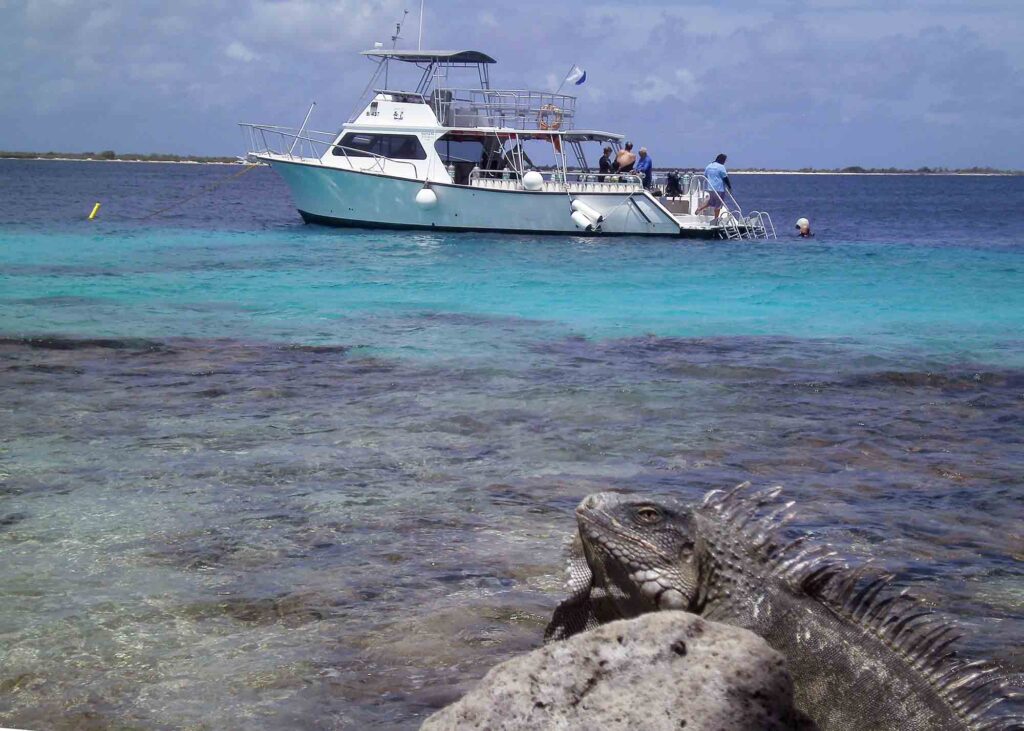
Al bought the property that is now Black Durgon Inn in 1982. It had a few rooms and was right on the water. “When we moved the operation from the hotel I decided to open a small, non-commercial operation using many of Captain Don’s methods.
“I refuse to change from the ‘Old Bonaire’ to commercial. I’m keeping Black Durgon Inn the way Bonaire used to be. We have 95% return guests. It will continue with the same ambience with my family, starting with my daughter Rona and my grandchildren and their grandchildren.” There is a certainty about Al Catalfumo that makes such a declaration unarguable.
Saving the wild donkeys
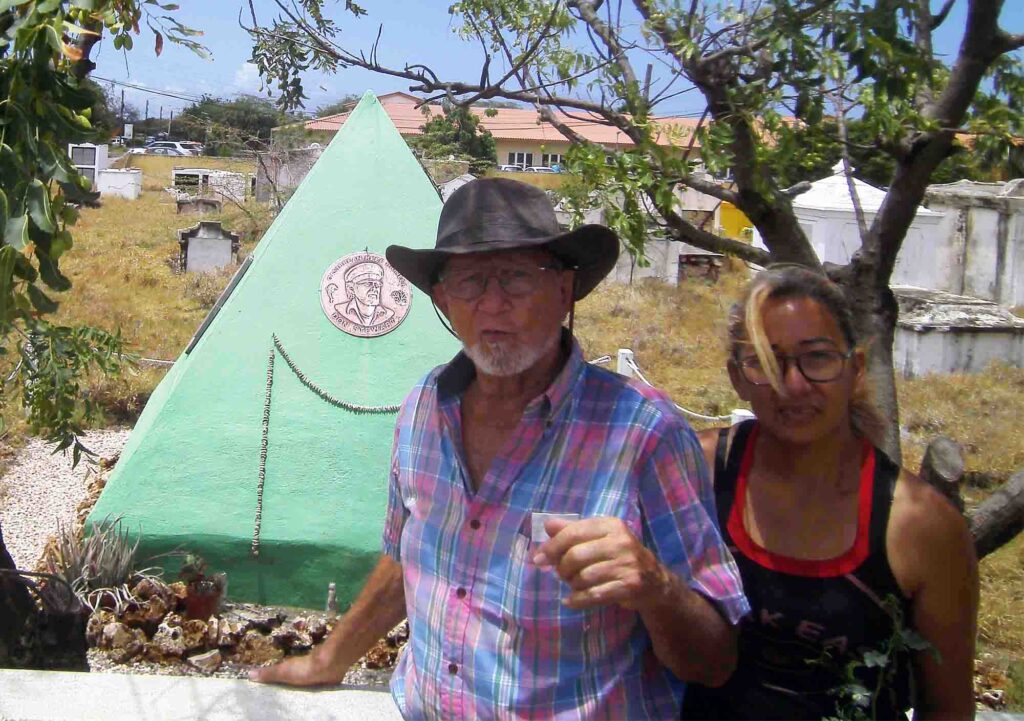
Certain too is Al’s devotion to preserving Bonaire’s free-roaming donkeys. He wears jeans, Western-style shirts and cowboy hats. His collection of hats ranges from relics of old decency in casual everyday wear to new ones for when he goes to town or special occasions.
Al loves horses, anything equine. He did have several, including a champion, Paso Fino, but gave them away and now focuses on saving the island’s wild donkeys.
“Over the past seven years we’ve been trying to protect historic Bonairian Nubian donkeys,” he tells me. “They were brought here by the Spanish and left wild as breeding stock.”
Alonso de Ojeda landed on Bonaire in 1499 with Amerigo Vespucci and Juan de la Costa. Costa’s map, drawn in 1500, named Bonaire Isla de Palo Brasil, or island of brasilwood. The Spanish considered Bonaire of no value, and deported its indigenous people to use as slaves elsewhere.
As wars raged in Europe among the great powers, the island changed hands back and forth between the British, Dutch and Spanish. Dutch West India Company ships called in at Bonaire in 1621, eventually conquering the island in 1636. Once a Dutch colony that included Aruba and Curaçao, since 2010 Bonaire has been a Special Municipality, part of the Netherlands.
Progress means concrete. Fly over Florida and look down. It is a mass of concrete paved over from top to bottom and coast to coast. The 288sq km island of Bonaire has not escaped its own deposits of concrete, but licence plates still proclaim: “Bonaire Divers Paradise”.
Under water pristine reefs remain, scrupulously protected with self-interest and economic survival in mind. On land, demand for idyllic lifestyles has added about 1,200 expatriates to an island of 20,104 inhabitants. And with Covid-19 restrictions on international travel lifted, divers are once again flocking to Bonaire to enjoy its relaxed lifestyle and natural beauty above and under the sea.
What does that mean for historic Nubian donkeys that traditionally wandered the island nibbling sparse grasses, clearing dry undergrowth that prevents fires, and became roadside attractions? It means that people intend to interfere with nature.
“Donkeys have survived on Bonaire for approximately 500 years,” says Al. “They were used by locals to transport water, grain, people. They took them from the wild as needed; some were sent to other islands. They survived and co-habitated with people until one man decided that donkeys have to go.”
Such decisions rankle with this diving pioneer, and the Bonaire Donkey Protection League insists that they are part of island heritage and an important element for wildlife tourists.
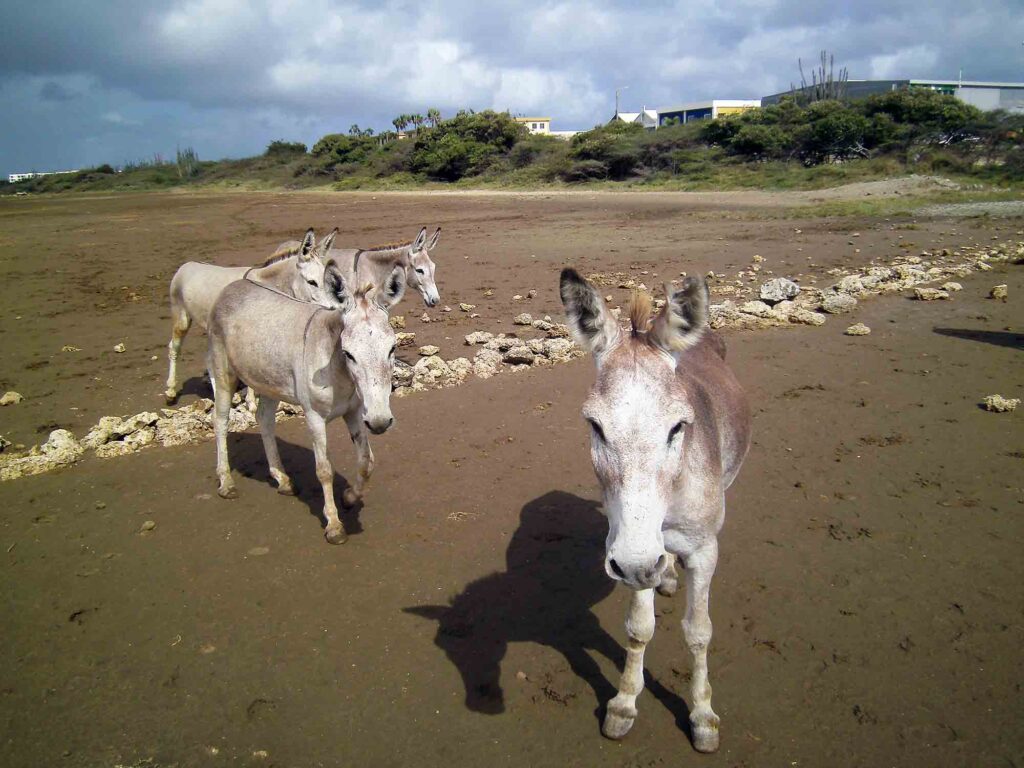
My vivid recollection of these innocent, docile creatures with distinctive crosses on their shoulders is of their inquisitive looks as we would make shore entries kitted up in dive equipment. Only 400 are reckoned to remain, after programmes of castration and euthanasia reduced the wild population.
“The rationale to eliminate donkeys was that they would do environmental damage,” said Al. “Twenty years later, Bonaire is greener than ever. There is no sound biology to say that donkey feet open soil and allow run-off into the sea. There is a nature plan for Bonaire to eliminate donkeys by 2030. We’re fighting to stop it.”
Completing the circle
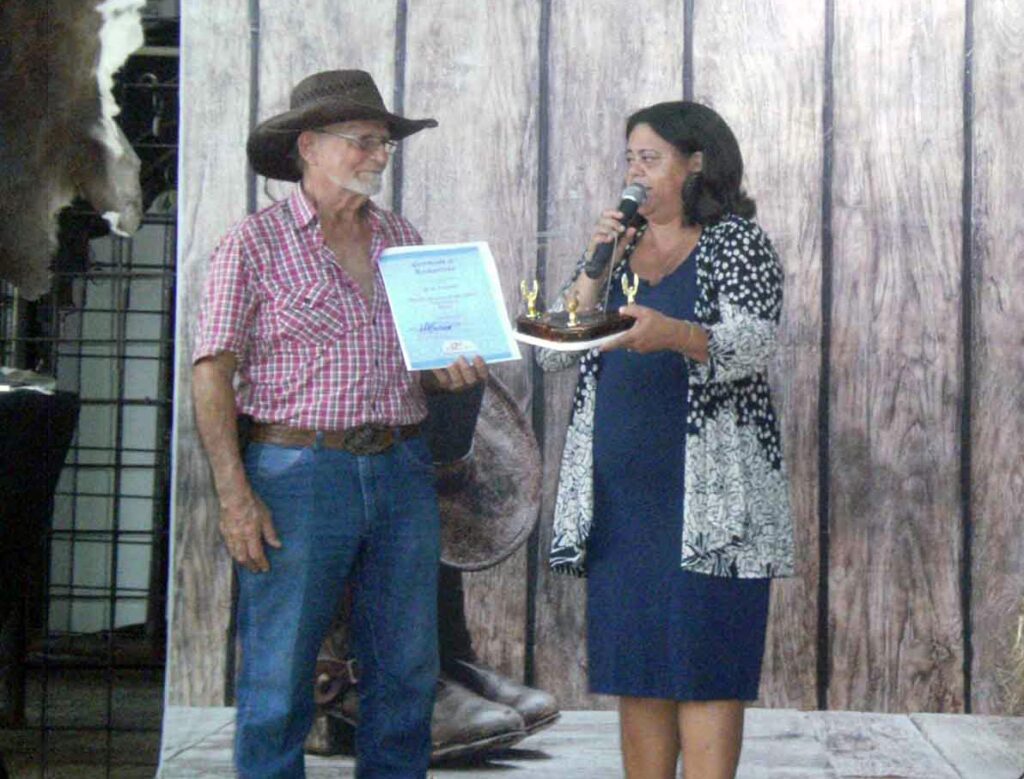
If the rationale for investment is to profit from tourism, the rationale for tourism on an island such as Bonaire is to retain wildlife that tourists come to see – and that includes on land as well as underwater creatures.
In all of this, concrete plays an important role. There are enough Cancuns in the world: concrete strips of tourist hotels, casinos, souvenir and duty-free shops – sterile places that attract visitors who stay a week, eat, drink, take the sun, smear on sunscreen and visit decimated reefs without life…
“I hate this phone. My friend Joel gave it to me. I can’t make it work. I’m on his plan…” Al’s mobile phone might be necessary for those who need to reach him. Few people now are without their tablets and mini-computers, plunking away at them on a veranda and ignoring the rollers crashing against the shore in the orange and red hues of the sun setting off Black Durgon’s dock.
Al Catalfumo set his course as a young man and kept to it. Leaving Bonaire, he drove me to a cemetery, where a green obelisk marks Captain Don Stewart’s grave. In a special way, that completed a circle. Bonaire is what it is because Don and Al made conservation a personal responsibility.
“My first dive on Bonaire was off the front porch of Hotel Bonaire,” says Rona. “‘We are going to fly,’ Ebo told me. Ebo Domacasse was one of the first dive-guides on Bonaire. I was 10 years old.”
Al’s grand-daughter Eloise is now 10, and soon she too will fly under water with her grandfather on this magical island, where wisdom of the people and the love, energy and devotion of dedicated divers has preserved nature for all time.

John Christopher Fine is a marine biologist and has dived shipwrecks all over the world. He is a Master Scuba Instructor, Instructor Trainer and the author of some 25 fiction and non-fiction books on a wide range of themes.
Also on Divernet: The Simple Life
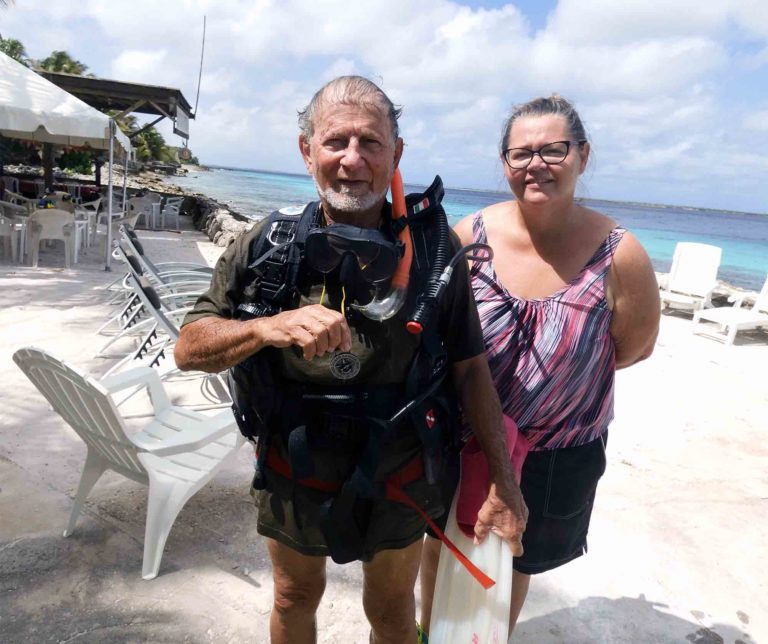

It it my privilege to have been a guest at the celebration of this wonderful friend. Right up there at the top of the pioneers who have made a wonderful mark of the history of this beautiful island I am blessed to all home & even more blessed to call him & his family friends.
Thanks for your generosity sharing your little piece of paradise with me.
Al for sure is one of the pioneer divers who made Bonaire known. Him and my father Juancho were great friends. My father was one who helped Capt Don to find his way on Bonaire, they were great friends, my father showed Capt Don all the dive sites he knew. Al reminds me a lot of my father, a great man who I am privileged to call him my friend despite the age difference. If the government follows his plan to keep our donkeys in the wild, Bonaire will be much better of.
I am still here!
Tom & Dee Napolitano
New Jersey